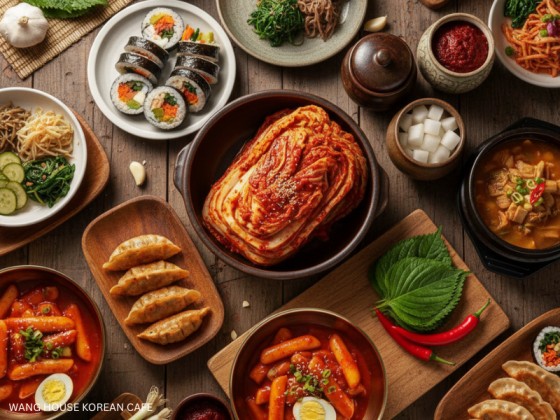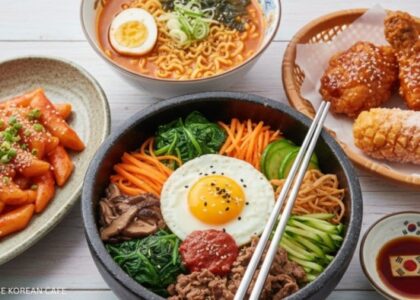Introduction
Healthy Korean Food has gained global attention for its balance of flavors, nutrition, and cultural depth. At Wang House – a Korean Street Food Café in India – we see every day how people love not only the taste but also the health benefits of Korean cuisine. From kimchi to fermented soy products, these dishes bring probiotics, vitamins, and antioxidants into your diet. They are not just about flavor; they are also about wellness and balance.
For a full list of our delicious fermented side dishes and mains, check out the Our Menu page at Wang House to see what fermented Korean Food items we offer.
The Role of Fermentation in Korean Cuisine
Fermentation is one of the oldest methods of food preservation in Korea. It transforms simple ingredients like cabbage, soybeans, and radishes into flavorful superfoods. This process creates beneficial bacteria that improve gut health and boost immunity. When you explore traditional market food in Korea, you will notice stalls filled with jars of kimchi, doenjang, and gochujang. These fermented staples remain at the heart of Korean meals.
Famous Korean Snacks That Are Fermented
While many people think only of kimchi, there are several other famous Korean snacks with fermented bases. Pickled radishes, soy-marinated eggs, and even fermented pancakes bring diversity to the table. These dishes often feature in a Seoul street food tour, offering a genuine taste of Korea’s culinary culture.
If you want low-calorie Korean dishes to try in India, fermented vegetables are the best place to start. They are crunchy, flavorful, and light on calories, making them perfect for those watching their diet.
If you want to visit us in person and try authentic Korean flavors, our Store Locator helps you find a Wang House cafe near you.
Why Fermented Foods Are Linked to Healthy Living
Fermented healthy Korean food is naturally rich in probiotics. These friendly bacteria improve digestion, reduce inflammation, and support stronger immunity. Another benefit is their high content of vitamins A, C, and K. When eaten regularly, they may help maintain healthy weight levels.
People searching for healthy vegetarian Korean recipes for lunch often include dishes like kimchi fried rice or tofu stew. These meals are filling yet packed with nutrients. If you are exploring Korean diet-friendly meals in restaurants, fermented side dishes (banchan) are always served to complement the main course.
Top Fermented Dishes to Try
1. Kimchi – The Global Star
Kimchi is made with napa cabbage, radish, garlic, ginger, and chili pepper. It is spicy, tangy, and refreshing. In any Seoul street food tour, kimchi is the first dish locals introduce to visitors. Many people in India now experiment with kimchi at home because it pairs well with rice, noodles, or even parathas.
2. Doenjang – Fermented Soybean Paste
Doenjang is an earthy paste used in soups and stews. It is an example of spicy Korean street eats that still manages to be healthy. Rich in protein and minerals, it adds depth to meals without high calories. If you are looking for high-protein Korean food options in cafes, doenjang stew is a must-try.
3. Gochujang – Red Chili Paste
This fermented chili paste gives a smoky and spicy flavor. It is essential in dishes like bibimbap and tteokbokki. While it is part of traditional market food in Korea, it has now become a global pantry item. Fitness lovers often use it in marinades for lean meat, making it a staple in Korean diet-friendly meals in restaurants.
4. Makgeolli – Fermented Rice Wine
Though a drink, makgeolli is also fermented and full of beneficial enzymes. It has a light fizz and is often found in famous Korean snack stalls. While not low-calorie, when enjoyed in moderation, it adds to the cultural richness of Korean dining.
To learn more about the origins and philosophy behind our flavor-forward Korean Street Food Cafe, see the About page for our story, mission, and kitchen practices.
Health Benefits of Fermented Foods
Improved Digestion
The probiotics in fermented foods keep the gut healthy. They balance the digestive system, which may reduce bloating and stomach issues.
Better Immunity
Fermented products are loaded with antioxidants that fight harmful bacteria and viruses. Eating them regularly can boost the body’s natural defenses.
Weight Management
If you are trying low-calorie Korean dishes in India, fermented vegetables and soybean soups are excellent. They are light yet filling, helping you avoid overeating.
More Energy
Fermented foods help the body absorb nutrients better. This means you get more energy from every meal. A bowl of kimchi rice can energize your afternoon better than many fast foods.
Curious about our past posts on regional flavor profiles or low-calorie Korean dishes? You can explore more in-depth at the Blogs section of Wang House.
How to Make Fermented healthy Korean Foods at Home
Homemade Kimchi
- Chop napa cabbage and soak it in salted water for 2–3 hours.
- Mix chili powder, garlic, ginger, and fish sauce or soy sauce.
- Coat cabbage with this paste and store it in a jar.
- Leave it to ferment at room temperature for 1–2 days, then refrigerate.
This recipe is also perfect for healthy vegetarian Korean recipes for lunch, especially when paired with rice.
Simple Doenjang Stew
- Boil water with seaweed and anchovies (or mushroom stock for vegetarians).
- Add doenjang paste, tofu, zucchini, and mushrooms.
- Simmer for 15 minutes and serve hot.
This stew is a great choice for Korean diet-friendly meals in restaurants, but it is also easy to prepare at home.
For partnership or expansion details, especially if you’re interested in Korean diet-friendly meals in restaurants or bringing Wang House to your city, check out our Franchise page.
Experiencing Fermented Foods at Wang House
At Wang House Korean Café, we bring the taste of Korea straight to India. Our menu highlights spicy Korean street eats, fermented side dishes, and even fusion bowls for modern palates. If you are searching for high-protein Korean food options in cafes, try our tofu bowls or chicken ramen with a side of kimchi.
For food lovers, every visit feels like a mini Seoul street food tour. You can explore not only famous Korean snacks but also hearty stews and bowls that are both tasty and healthy. If you are in Delhi-NCR or Kochi, this is your chance to explore traditional market food and Korean flavors without traveling abroad.
Conclusion
Fermentation has shaped Korean cuisine for centuries, making it delicious and nutritious. From kimchi to soybean pastes, these foods improve gut health, immunity, and energy levels. For those searching for low-calorie Korean dishes to try in India or experimenting with healthy vegetarian Korean recipes for lunch, fermented Korean dishes offer endless choices.
At Wang House, we believe food should be both enjoyable and nourishing. Whether you want Korean diet-friendly meals in restaurants or high-protein healthy Korean food options in cafes, our menu brings authentic flavors closer to home. By adding fermented dishes to your diet, you embrace both tradition and wellness – the true meaning of Healthy Korean Food.
General Questions and Answers Based on the Blog:
1.
Q: What makes Healthy Korean Food different from other cuisines?
A: Healthy Korean Food is unique because it focuses on balance, using fermented dishes like kimchi, doenjang, and gochujang. These foods are packed with probiotics, low in calories, and high in vitamins, making them healthier than many fast-food options.
2.
Q: Where can I try low-calorie Korean dishes to try in India?
A: You can explore low-calorie Korean dishes to try in India at Wang House outlets in Delhi and Kochi. From kimchi fried rice to tofu soups, our menu offers light yet filling meals perfect for diet-conscious foodies.
3.
Q: Do you serve healthy vegetarian Korean recipes for lunch?
A: Yes! Wang House specializes in healthy vegetarian Korean recipes for lunch, such as vegetable ramen, tofu bowls, and Korean egg rolls. These dishes are both nutritious and flavorful, ideal for those following vegetarian or balanced diets.
4.
Q: What are some high-protein healthy Korean food options in cafes?
A: At Wang House, our high-protein Korean food options in cafes include chicken ramen and tofu rice bowls. These meals provide a rich source of protein while staying true to authentic Korean flavors.
5.
Q: Can I find Korean diet-friendly meals in restaurants near me?
A: Absolutely! If you are searching for Korean diet-friendly meals in restaurants, Wang House offers plenty of options. From fermented side dishes to spicy ramen bowls, our menu caters to health-minded guests without compromising on taste.






